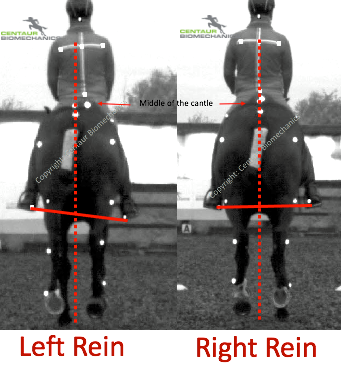
The answer to this may seem obvious however, sometimes riders are unaware that one stirrup is longer than the other and furthermore, riders (and trainers) may deliberately alter one stirrup as a possible solution to help “improve” the riders’ position or manage rider limb length differences.
In some cases, when rider’s ride on one rein they may feel more symmetrical than when riding on the other rein. On the rein where they feel less symmetrical, the rider would usually feedback that their seat/hips are consistently slipping out to one side. From a visual observation, when the rider is riding towards you, it may appear that the stirrups look equal and when riding towards you on the opposite rein, the outside stirrup may appear longer. This observation will generally coincide with the rider’s feedback that their seat/hips are displacing to the outside. At first glance, it may seem that the rider is putting increased weight in the outside stirrup due to it being “longer” which is causing the riders seat/hips to displace towards the side with the longer stirrup. Therefore, based on this visual observation, riders (and trainers) shorten the stirrup to make them appear visually “symmetrical”.
The key word used here is “appear”. What needs to be considered here is the position of the saddle. We (1) and others (2, 3) have demonstrated that saddle slip generally occurs on one rein as a result of the horse’s locomotor system. As saddle slip generally occurs on one rein, this will have a significant effect on the rider’s position. In the above scenario, with the saddle slipping to the outside, this will change the position of the stirrup bar (relative to the horse) which will give the appearance that the stirrup is longer on the side that the saddle has slipped towards, and the rider will follow the saddle causing them to displace their seat/hips (Image: Left rein). When on the other rein, as the saddle is “straight” the position will be improved (Image: Right rein).
In the above scenario (saddle slip right, right stirrup appears longer and riders seat displaced to the right), if the right stirrup is shortened this will compound the issue further as an element of rider asymmetry will be induced into the horse-rider system as a function of different stirrup lengths (4). When assessing stirrup length dynamically, it is important to assess the position of the saddle relative to the horse. This observation must be made from a rear viewpoint, with the horse/rider going away and must be performed on both the left and right rein and in all gaits (if appropriate). If the stirrups “appear” to be different because of saddle position, then initially this must be addressed with the qualified saddle fitter (and others). In the above case, riders and trainers should avoid the temptation to shorten one stirrup to resolve the issue as this is not addressing the fundamental reasoning i.e. why is the saddle slipping?
In addition to this, riders often report that they have one leg longer and then self-prescribe a plan to alter one stirrup. This will be addressed in a future blog, but caution should be taken over this, along with clarification from a specialist, confirming if the rider has an actual or functional limb length difference. In either case, it is imperative that riders seek clarification on this before altering stirrups, as for reasons outlined in previous blogs, riding with asymmetric stirrups will cause the horse to seek a locomotor compensation strategy to compensate.
So to answer the initial question, it is important that the length of the stirrup is equal and not asymmetrically altered to “correct’ saddle or rider position.
Check your stirrup leathers regularly to ensure that they are symmetrical and get someone to watch you ride away from a left and right rein approach.
Please like / follow our page for more blogs and please share to raise awareness.
Dr. Russell MacKechnie-Guire
Centaur Biomechanics
www.centaurbiomechanics.co.uk
#equineresearch #biomechanics #centaurbiomechanics #veterinarymedicine #equinephysiotherapy #equinetherapist #onlinecourses #onlineseminar
1. Mackechnie-Guire R, Mackechnie-Guire, E., Fisher, M., Mathie, H., Bush, R., Pfau, T., Weller, R. Relationship between saddle and rider kinematics, horse locomotion and thoracolumbar pressures in sound horses. JEVS. 2018;69:43.52.
2. Greve L, Dyson SJ. An investigation of the relationship between hindlimb lameness and saddle slip. Equine Vet J. 2013;45(5):570-7.
3. Greve L, Dyson SJ. The interrelationship of lameness, saddle slip and back shape in the general sports horse population. Equine Vet J. 2014;46(6):687-94.
4. MacKechnie-Guire R, MacKechnie-Guire E, Fairfax V, Fisher M, Hargreaves S, Pfau T. The Effect That Induced Rider Asymmetry Has on Equine Locomotion and the Range of Motion of the Thoracolumbar Spine When Ridden in Rising Trot. Journal of Equine Veterinary Science. 2020;88:102946